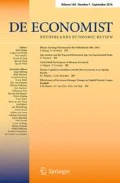References
For instance M. Abramovitz, Economics of Growth, in “A Survey of Contemporary Economics”, Volume II (Homewood, Ill. 1952) pleads (pp. 176–178) that “the economics of growth is ...... the field of work in which the dependence of economics upon its sister sciences appears in a supreme degree”.
J. Tinbergen, On the Theory of Economic Policy (Amsterdam, 1952); see also Scope and Methods of the Central Planning Bureau (The Hague, 1956). For an interesting discussion of Tinbergen's methods, see W. A. Jöhr and H. W. Singer, The Role of the Economist as Official Adviser (London, 1955, pp. 95–105). For a more recent introduction, see J. Tinbergen, The Design of Development (Baltimore, 1958).
Bert F. Hoselitz, Non-economic Factors in Economic Development, Am. Ec. Rev., Vol. XLVII, no. 2 (May 1957), p. 36. The periodical “Economic Development and Cultural Change”, edited by Hoselitz, stresses, as indicated by its title, non-economic factors. Of the extensive literature two recent books, devoting much discussion to the role of non-economic factors in economic development, may be mentioned: Norman S. Buchanan and Howard S. Ellis, Approaches to Economic Development (New York, 1955) and W. Arthur Lewis, The Theory of Economic Growth (London, 1955). Cf. also J. J. Spengler's nineteen determinants in “Theories of Socio-Economic Growth”, Problems in the Study of Economic Growth, National Bureau of Economic Research (New York 1949). For a recent summary of groups of determinants of economic growth, cf. “The Role of Foreign Aid in the Development of Other Countries”, a study prepared at the request of the Special Committee to Study the Foreign Aid Program, United States Senate, by the Research Center in Economic Development and Cultural Change of the University of Chicago (Washington, 1957).
Jacob Viner, International Trade and Economic Development (Glencoe, Ill., 1952), pp. 126 and following.
For some common patterns in the statistical record of economic growth, cf. the fascinating study of S. Kuznets, Quantitative Aspects of the Economic Growth of Nations, I, Levels and Variability of Rates of Growth, in “Economic Development and Cultural Change”, Vol. V., nr. 1, October 1956.
P. Wignaraja, Some Reflexions on Rational Policy for Economic Development in Underdeveloped Areas, Economic Development and Cultural Change, Vol. II, no. 2 (June 1953).
Cf. Modern Sociological Theory in Continuity and Change (ed. by H. Becker and A. Boskoff), New York, 1957, p. 268.
For the first results of this work programme, see “Industrialization and Productivity”, Bulletin no. 1, United Nations, New York, 1958.
Netherlands Economic Institute, Division for Balanced Economic Growth, Alternative Techniques of Production, a case study (Rotterdam, 1957).
Additional information
The author wishes to thank M. H. Ekker, H. W. Singer and J. Tinbergen for encouraging suggestions and criticisms. Any mistakes that remain are his responsibility.
Rights and permissions
About this article
Cite this article
Kaufmann, J. Economic theory, economic policy and the need for an interdisciplinary approach to problems of the economic development of underdeveloped areas. De Economist 107, 81–90 (1959). https://doi.org/10.1007/BF02192691
Published:
Issue Date:
DOI: https://doi.org/10.1007/BF02192691

